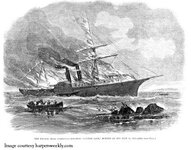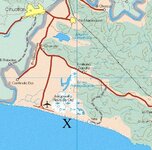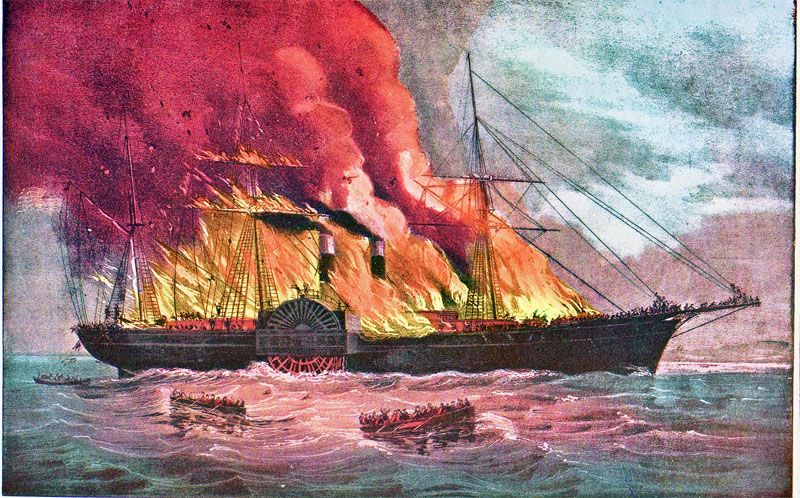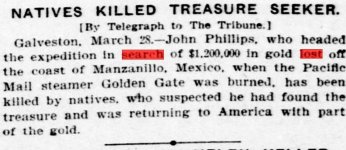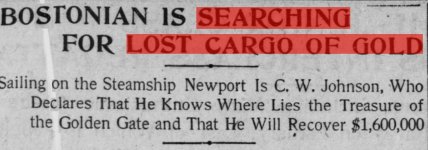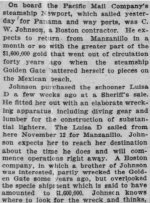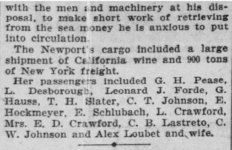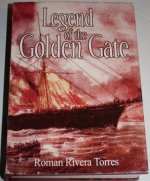I've done some research on the Golden Gate, and I believe there still may be enough gold coins on the site/surf to make the casual diver/beach hunter happy.
The wooden side-wheel steamship GOLDEN GATE was built for the Pacific Mail Steamship Co by William H. Webb, New York (hull #56); keel laid 1 July 1850, launched 21 January 1851, along with the sailing ship ISAAC BELL (for Fox & Livingston) and the clipper GAZELLE (for Taylor & Merrill). 2067 tons; 262 feet x 40 feet x 30 feet 6 inches (length x beam x depth of hold); 2 funnels, 3 masts, 3 decks, round stern, round tuck, spread-eagle head; mean draft 10 ft 2 in, load draft 13 ft 8 in; two oscillating engines (Novelty Iron Works): bore 85 inches, stroke 9 feet, steam pressure 18 psi, approximate ihp 1150, 14 revolutions per minute; wheel diameter 33 feet 6 inches, float width 10 feet 6 inches.
2 August 1851, maiden voyage, New York - Rio de Janeiro - Valparaiso - Panama (arrived 16 October) - San Francisco (arrived 19 November 1851; her passage from Panama to San Francisco of 11 days, 4 hours, stood as a record until 1855). The GOLDEN GATE entered the Panama-San Francisco service, where she proved a fast, but unlucky vessel: in 1852, an outbreak of cholera aboard resulted in 84 deaths; in May 1853, she nearly collided with the Vanderbilt steamship SIERRA NEVADA off the Mexican coast; 1854, engine breakdown and grounding at Point Loma; October 1857, broken shaft. 24 July 1862, sailed from San Francisco for Panama. 27 July, about 15 miles from Manzanillo, Mexico, fire was discovered in the engine room, and the vessel was headed for what is now called Playa de Oro, in order to beach her. Many of the passengers sought refuge in the stern, but the flames spread in that direction, and when boats were launched in the heavy surf the occupants were crushed against the ship or drowned; the ship broke up in the surf. Between 175 [Dunbaugh and Thomas] and 223 [Kemble] passengers and crew lost their lives, together with the baggage, mail, and nearly all the cargo of $1.4 million in specie (gold valued at $300,000 was recovered from the wreck and brought to San Francisco by the Pacific Mail steamship CONSTITUTION in February 1863).
I don't have the exact coordinates, but my "X" on the map shows the general location.
The wooden side-wheel steamship GOLDEN GATE was built for the Pacific Mail Steamship Co by William H. Webb, New York (hull #56); keel laid 1 July 1850, launched 21 January 1851, along with the sailing ship ISAAC BELL (for Fox & Livingston) and the clipper GAZELLE (for Taylor & Merrill). 2067 tons; 262 feet x 40 feet x 30 feet 6 inches (length x beam x depth of hold); 2 funnels, 3 masts, 3 decks, round stern, round tuck, spread-eagle head; mean draft 10 ft 2 in, load draft 13 ft 8 in; two oscillating engines (Novelty Iron Works): bore 85 inches, stroke 9 feet, steam pressure 18 psi, approximate ihp 1150, 14 revolutions per minute; wheel diameter 33 feet 6 inches, float width 10 feet 6 inches.
2 August 1851, maiden voyage, New York - Rio de Janeiro - Valparaiso - Panama (arrived 16 October) - San Francisco (arrived 19 November 1851; her passage from Panama to San Francisco of 11 days, 4 hours, stood as a record until 1855). The GOLDEN GATE entered the Panama-San Francisco service, where she proved a fast, but unlucky vessel: in 1852, an outbreak of cholera aboard resulted in 84 deaths; in May 1853, she nearly collided with the Vanderbilt steamship SIERRA NEVADA off the Mexican coast; 1854, engine breakdown and grounding at Point Loma; October 1857, broken shaft. 24 July 1862, sailed from San Francisco for Panama. 27 July, about 15 miles from Manzanillo, Mexico, fire was discovered in the engine room, and the vessel was headed for what is now called Playa de Oro, in order to beach her. Many of the passengers sought refuge in the stern, but the flames spread in that direction, and when boats were launched in the heavy surf the occupants were crushed against the ship or drowned; the ship broke up in the surf. Between 175 [Dunbaugh and Thomas] and 223 [Kemble] passengers and crew lost their lives, together with the baggage, mail, and nearly all the cargo of $1.4 million in specie (gold valued at $300,000 was recovered from the wreck and brought to San Francisco by the Pacific Mail steamship CONSTITUTION in February 1863).
I don't have the exact coordinates, but my "X" on the map shows the general location.


